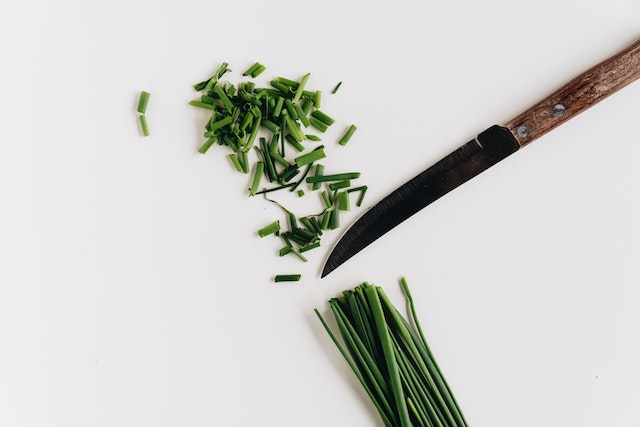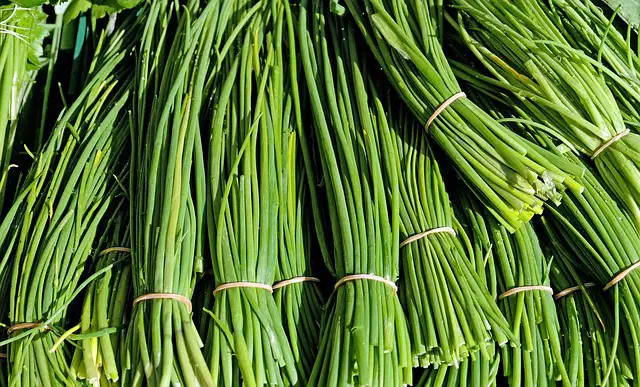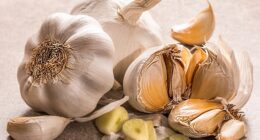Chives are thin, tubular leaves with a delicate onion flavor. Green onions have thicker stems and a stronger taste with a bulb at the bottom.
TL;DR Chives Vs. Green onions
Chives are delicate herbs with a mild onion flavor and vibrant green color. They are mostly used as a garnish or added at the end of cooking to preserve their delicate taste.
Green onions, also known as scallions, have a more pronounced onion flavor and can be used in various dishes. They add a crisp texture and subtle sweetness when cooked or eaten raw.
What are chives?

Chives, also known by their scientific name Allium schoenoprasum, are characterized by their long, slender green stems and mild onion-like flavor. Chives have been used in culinary dishes for centuries due to their versatile nature and delicate taste.
Chives have thin stalks with hollow centers, much like grass blades. These tender shoots can grow up to 20 inches tall and are typically harvested before they flower to maintain optimal flavor.
Chives offer a milder alternative to traditional onions or garlic. Their subtle onion taste adds a gentle kick without overpowering other ingredients in a dish.
What are green onions?

Green onions, also known as scallions or spring onions, have long, slender green stalks and small white bulbs at the base. Green onions have a mild onion flavor that is less pungent than regular onions.
These versatile vegetables can be enjoyed raw or cooked and are often used to add a fresh and crisp element to dishes.
The green parts of the onion can be sliced thinly for garnishing salads, soups, and stir-fries, while the white parts can be chopped and sautéed with other ingredients.
Chives Vs. Green onions – Key differences
| Aspect | Chives | Green Onions |
|---|---|---|
| Plant Part | Thin, tubular leaves | Thick stems with a bulb at the bottom |
| Flavor | Delicate onion taste | Stronger onion flavor with a hint of garlic |
| Appearance | Slender and grass-like | Thicker and more robust |
| Culinary Use | Garnish, salads, and as a subtle flavor enhancer | Cooked or raw in various dishes, including salads, stir-fries, and soups |
| Aroma | Mild and fresh | Intensely aromatic with a pungent smell |
| Plant Type | Perennial herb | Biennial or perennial depending on the variety |
| Allium Species | Allium schoenoprasum | Allium fistulosum |
| Bulb Formation | No bulb formation | Forms a small bulb at the base of the stem |
Chives – Nutrition values
Here are the approximate nutrition values for 100 grams of fresh chives:
- Calories: 30 kcal
- Carbohydrates: 4.35 grams
- Protein: 3.27 grams
- Fat: 0.73 grams
- Fiber: 2.5 grams
- Vitamin A: 4353 IU
- Vitamin C: 58.1 mg
- Vitamin K: 212.7 μg
- Folate: 105 μg
- Calcium: 92 mg
- Iron: 1.60 mg
- Magnesium: 42 mg
- Potassium: 296 mg
Chives are low in calories and fat, rich in vitamins A and C, and a good source of minerals like calcium, iron, and magnesium.
They also provide antioxidants and contribute to the overall nutrient intake when used in various culinary applications.
Green onions – Nutrition values
Here are the approximate nutrition values for 100 grams of fresh green onions (also known as scallions or spring onions):
- Calories: 32 kcal
- Carbohydrates: 7.34 grams
- Protein: 1.83 grams
- Fat: 0.22 grams
- Fiber: 2.6 grams
- Vitamin A: 1450 IU
- Vitamin C: 18.8 mg
- Vitamin K: 207 μg
- Folate: 64 μg
- Calcium: 72 mg
- Iron: 1.48 mg
- Magnesium: 20 mg
- Potassium: 276 mg
Green onions are low in calories and fat, a good source of dietary fiber, and rich in vitamins A, C, and K.
They also provide minerals like calcium, iron, and potassium, making them a nutritious addition to various dishes.
Can You Substitute Chives for Green Onions?
Yes, chives can be used as a substitute for green onions in many recipes. While they have some differences in flavor and appearance, they both belong to the onion family and can provide a similar onion-like taste to dishes.
Chives have a milder and more delicate flavor compared to green onions, so you may need to adjust the quantity to match the desired level of onion flavor.
Also since chives are thinner and grass-like, they work well as a garnish or subtle flavor enhancer in salads, soups, and other dishes where a more delicate onion flavor is preferred.
Green Onion dishes
- Stir-Fries: Green onions are often added to stir-fries, providing a fresh and crisp texture along with a mild onion taste.
- Noodles and Rice Dishes: They are used as a garnish or mixed into noodle dishes and fried rice for added flavor and color.
- Soupsand Stews: Green onions make a great addition to various soups and stews, both as an ingredient and as a garnish.
- Salads: Chopped green onions can add a refreshing kick to salads, especially potato salads, coleslaw, or mixed greens.
- Asian Dishes: They are frequently used in Asian cuisines, like Chinese, Japanese, and Korean dishes, as an essential ingredient or garnish.
- Omelets and Scrambled Eggs: Green onions can be mixed into omelets or scrambled eggs for extra flavor and a pop of color.
- Sauces and Dips: They can be added to sauces and dips like salsa, guacamole, or tzatziki, enhancing the overall taste.
- Grilled and Roasted Meats: Grilled or roasted meats can be garnished with chopped green onions for a burst of freshness.
- Spring Rolls and Wraps: Green onions are often included in spring rolls, summer rolls, or wraps for an added layer of flavor.
- Garnish: They can be used as a garnish on various dishes, including soups, salads, tacos, and sushi rolls.
Chive dishes
- Potato Dishes: Chives are often sprinkled over baked or mashed potatoes for added flavor and a pop of color.
- Creamy Soups: They are used as a garnish for creamy soups like potato leek soup or cauliflower soup.
- Eggs: Chives can be mixed into scrambled eggs, omelets, or frittatas, providing a light onion taste.
- Salads: Chopped chives can be added to salads, especially egg salads, tuna salads, or mixed greens.
- Fish and Seafood: They are often used as a garnish for fish and seafood dishes, enhancing their taste.
- Sauces and Dips: Chives can be mixed into sauces and dips like sour cream-based dips or hollandaise sauce.
- Cream Cheese Spread: Chopped chives are a classic addition to cream cheese spreads for bagels or sandwiches.
- Butter: Chives can be mixed into softened butter to create a flavorful chive butter, perfect for bread or grilled corn.
- Rice and Grain Dishes: They can be sprinkled over rice, quinoa, or other grain dishes for added taste and color.
- Garnish: Chives are commonly used as a garnish on various dishes, adding a touch of freshness and visual appeal.
Image Credits
Featured Image By – 1195798 from Pixabay
Image 1 By – Mike Goad from Pixabay
Image 2 By – Photo by alleksana on pexles









